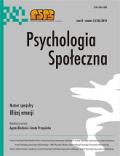Ile jest Ja w emocjach samoświadomościowych? Rodzaj zaangażowania Ja a wstyd, poczucie winy i zakłopotanie
How many selves is in the self-conscious emotions? Commitment of the self and shame, guilt and embarrassment
Author(s): Barnaba DanielukSubject(s): Psychology
Published by: Wydawnictwo Naukowe Scholar Sp. z o.o.
Keywords: shame; guilt; embarrassment; public self-consciousness; private self-consciousness; ideal-self, reflected-self; self-attribution
Summary/Abstract: In American literature the dominant conceptualization of shame and guilt is based on self-attributional processes (Lewis, 1992; Tangney and Dearing, 2004; Tracy and Robins, 2004). In this approach shame is accompanied by general negative attributions focused on the entire self, whereas guilt is connected to specific attributions focused on behavior. This approach assumes that private self-awareness plays the main role in experience of both types of emotions and it ignores the traditional distinction based on the private-public dimension, as present in anthropology. However, many scientists point to the significant role of the public self-consciousness in experiencing shame and guilt. Results of two experiments are presented, which aim was to verify the role of the self-attributional dimension as well as to check the alternative hypothesis that distinguishes between shame, guilt and embarrassment. Three themes are taken into consideration: focusing on the self-presentational concerns, focusing on the discrepancies between actual self and ideal self, focusing on the deed and its consequences. Results suggests, that guilt is strictly connected with private self-consciousness, self reflection and negative self-evaluation (mainly from the perspective of personal standards). Shame, which is experienced in a state of public self-consciousness, is a consequence of perceived negative external (social) evaluation, but includes motives of critical self-evaluation. Embarrassment, on the other hand, is not exclusively the mild form of shame, but has his own distinct features.
Journal: Psychologia Społeczna
- Issue Year: VIII/2013
- Issue No: 26
- Page Range: 302-322
- Page Count: 21
- Language: Polish

